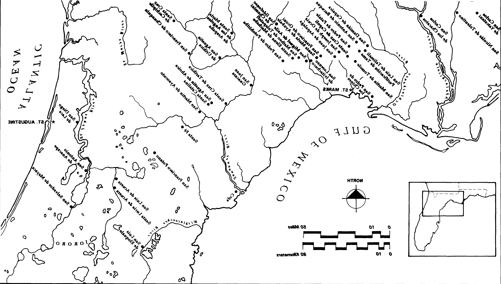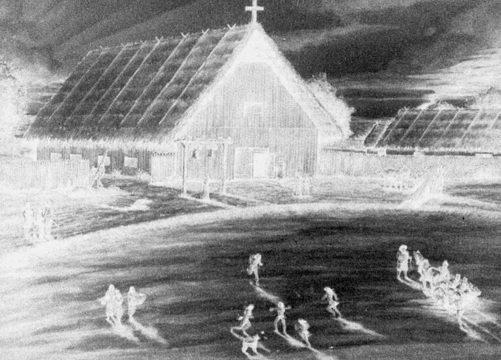The History of Florida (22 page)
Read The History of Florida Online
Authors: Michael Gannon
Tags: #History, #United States, #State & Local, #Americas

authority did not suffice to assure the priests a friendly reception. Jeering,
jostling, and even threats of bodily harm greeted the friars’ first efforts there.
The first friars venturing into Apalachee between 1608 and 1612 at the invita-
tion of its most prestigious chief were twice forced to leave because of the

y.
turen
th c
teenen
proof
ida in the sevlor
ior of Fter
ranciscan missions in the in
tions of F
Names and loca
100 · John H. Hann
unruliness of Indians who did not obey their chiefs wel . In deferring the
effort there, both governor and friars cited a need for soldiers among their
reasons for doing so. Yustaga’s head chief initial y refused friars entry to
work in his territory. Even after admitting two friars, for a time he forbade
any of his subjects to be baptized. In the hinterland, Spaniards resorted to
a degree of compulsion only among the Chacato of the Panhandle, a few
months after the launching of missions there, when opposition to the friars’
presence developed.
Steady and, at times, spectacular shrinking of the population accompa-
nied spread of the missions, resulting largely from the Indians’ exposure to
new diseases brought by outsiders. The magnitude of the population loss is
unknown because demographic information is scant and usual y imprecise.
There are no global estimates for any people in the sixteenth century and
none for the first three-quarters of the seventeenth century, except for the
Apalachee.
The size of Guale’s population in the 1560s or later when they began to
be Christianized is among the least known. The only data recorded are that
more than 1,200 had been baptized by 1597, that Guale were more populous
in 1602 than the coastal and Freshwater Timucua, and that 756 Guale were
confirmed by Cuba’s bishop in 1606. There are no indications of the size of
proof
individual vil ages until 1675.
For coastal and Freshwater Timucua in the 1560s, there are offhand state-
ments about the numbers of warriors whom leaders assembled on several
occasions. Based on those statements, demographer Henry Dobyns sug-
gested a total Saltwater population of 7,500 to 10,000 for that era. In 1602,
friars provided precise figures on the Christian population of each of the
three Saltwater missions of that period (San Pedro 792, San Juan 500, Nom-
bre de Dios 200) and, in the case of San Pedro, figures for its individual
subordinate vil ages. The figures for San Pedro (500) represented the entire
population of Cumberland Island at that time. Six Freshwater vil ages on
the St. Johns and Mayaca held about 200 Christians in 1602, and Mayaca
had about 100 people yet to be baptized. The other Freshwater vil ages on
the St. Johns presumably were still heathen. Most of San Sebastian’s people
perished in a hurricane shortly before 1602. In 1606 a visiting bishop from
Cuba confirmed 1,003 Saltwater Timucua and 315 Freshwater Timucua and
Mayaca. On the south Georgia coastal mainland, the 1,100 people in Ycafui’s
eight vil ages had been catechized by 1602, but the 700 to 800 in Ibi’s five
settlements were still heathen. The scant data for the 1560s suggest that the
The Missions of Spanish Florida · 101
Saltwater and Freshwater Timucua populations had declined drastical y by
1602.
Among the hinterland Timucua in this period, the data are best for Po-
tano. Early in November 1607, two friars reported more than 1,000 adult
baptisms among the Potano over the previous year. The friar who launched
the work in four settlements in the vicinity of Gainesville baptized the 400
people of each of two of the settlements and 200 people in a third. Together
with the children they were a major portion of the more than 4,000 baptized
between mid-1606 and the end of 1607. By then another 1,000-plus were
being catechized. Over the next nine years the number of Christianized na-
tives rose to more than 16,000, but a series of epidemics beginning in 1614
halved that Christian population and undoubtedly took an equal y heavy
toll on the non-Christianized who were in contact with them.
We have the fewest data about the size of Utina’s population in the mis-
sion era and earlier. Hernando de Soto found it to be more populous and
better provisioned than lands such as Potano that he had passed through
earlier. A remark in 1616 that after the first five years of a friar’s work at
Tarihica there were 712 living Christian Indians may provide an indicator
of Utina mission size. If Tarihica’s Christian population lost half its numbers
in the 1614–16 epidemics, it would rank with the largest Apalachee mission
proof
centers of 1675, as did the head chief’s jurisdiction of Ayaocuto with its 1,500
people distributed over five settlements.
Dobyns used a French remark that Yustaga’s head chief of the 1560s could
put 3,000 or 4,000 warriors in battle to estimate a total population of 15,000
or 20,000. The baptism of 13,000 people during the first twelve years of the
friars’ work in Yustaga suggests at least that large a population, as does the
marked preponderance of Yustaga among western Timucua’s surviving
population in 1675.
Global estimates made from 1608 to the 1630s placed Apalachee’s pop-
ulation during those years at 30,000 to 34,000. Other estimates from the
1630s placed it at 15,000 or 16,000. A friar gave a late 1640s figure of 20,000.
The higher estimates are not inconceivable in view of Apalachee’s surviving
population of about 10,000 as late as 1675. At the start of missionization in
the 1630s that population was distributed over more than forty settlements
under the jurisdiction of ten principal chiefs who headed the missions in
existence in 1657. Until the 1650s Apalachee was less affected by epidemics
than were the other mission territories.
By the 1670s an eleventh Apalachee mission had been established, and

102 · John H. Hann
An artistic reconstruction of the Franciscan mission church of San Luis de Talimali at
Tallahassee. Archaeological excavations reveal that the Apalachee churches were con-
structed of plank and thatch. The dimensions of this particular church in the Florida
hinterland, 110 by 50 feet, make it as large as the seventeenth-century parish church in
proof
the capital city of St. Augustine. Artist: John LoCastro; original watercolor, 1993,
After-
noon at Mission San Luis
.
the province was host to six or more other peoples who migrated into the
province. Three missions were established among the immigrant Chine,
Amacano, Pacara, Chacato, and Tama-Yamasee. The sixth group, Tocobaga
from the Tampa Bay region, apparently never showed interest in receiving
a friar. The Chacato migrants were refugees from one of the last efforts to
expand the scope of the missions. In mid-1674, two months after the es-
tablishment of the Chine-Amacano-Pacara mission, friars established two
missions in the Chacato homeland near Marianna, which ended a year later
with the revolt and flight of most of the Chacato. A contemporaneous short-
lived third mission on the Apalachicola River served a small band of Saba-
cola who had migrated downriver from the vicinity of Columbus, Georgia.
Governor Pablo de Hita Salazar gave impetus to the last expansion of
the Florida missions. It began with resurrection of missions at Anacape
near Welatka and Mayaca to serve Yamasee who had moved to the upper
St. Johns River. Friars then moved southward from Mayaca into the lakes
district to establish five short-lived missions among the Mayaca-speaking
The Missions of Spanish Florida · 103
Jororo and the Aypaja by the 1690s. The effort col apsed essential y in 1696–
97 when the Jororo of Atoyquime killed their friar and his Guale assistants.
A renewed approach to the Calusa in September 1697 ended several months
later when Indians stripped the friars of even their clothing and deposited
them on Matecumbe Key, where a Spanish vessel eventual y rescued them.
The fol owing is a listing of the more enduring missions arranged by
province or geographic area. Those marked with a pound sign probably
had died out by 1655. Those marked with an asterisk had ceased to exist by
1675 or had merged with another mission. Population statistics are given for
most of the missions that existed in 1675 and in 1689. The first figure is the
one for 1675.
Coastal Timucua
Nombre de Dios
—
100
San Sebastian#
San Juan del Puerto
30
125
San Pedro Mocama*
San Buenaventura de Guadalquini
40
300
San Lorenzo de Ibiica#
Santiago de Ocone*
St. Johns and Ocklawaha valleys
proof
San Antonio de Anacape*
—
150
San Diego de Laca or Salamototo
40
200
San Salvador de Mayaca*
Santa Lucia de Acuera*
San Luis de Acuera or Avino*
Guale and other north Georgia missions
Santa Catalina de Guale
140
150
Santo Domingo de Asao or Talaje
30
125
San Pedro or San Felipe de Athuluteca
36
200
Santa Clara de Tupiqui*
San Diego de Satuache*
San Joseph de Sapala
50
—
Nra. Sra. de Guadalupe de Tolomato
—
125
Western Timucua
San Francisco de Potano
60
125
Santa Fe
110
180
San Martin de Ayaocuto*
Sta. Cruz de Tarihica
80
100
San Agustin or/and Sta. Catalina de Ahoica
60
200
Sta. Catalina
80
—
San Juan Guacara
80
150
104 · John H. Hann
Sta. Cruz de Cachipile*
San Agustin de Urihica*
San Francisco de Chuaquin*
San Ildefonso de Chamini*
Sta. Maria de los Angeles de Arapaha*
Sta. Isabel de Utinahica#
San Luis de Eloquale (Ocale)#
San Pedro y San Pablo de Potohiriba
300
750
Sta. Elena de Machaba
300
500
San Matheo de Tolapatafi
300
250
San Miguel de Asile
40
150
Chacato
San Carlos de Yatcatani
400
150
San Nicolas de Tolentino
100
350
Apalachee
San Lorenzo de Ivitachuco
1200
1000
San Luis de Talimali
1400
1500
Sta. Maria de Ayubale
800
1200
San Francisco de Oconi
200
400
San Joseph de Ocuia
900
1000
San Juan de Aspalaga
800
250
San Pedro y San Pablo de Patale
500
600
San Antonio de Bacuqua
120
250
proof
San Cosme y San Damian de Cupaica or Escambe
900
2000
San Martin de Tomole
700
650
Sta. Cruz de Capoli or Ychutafun
60
150
Purificacion de Tama or Candelaria
300
400
San Pedro de los Chines
300